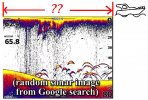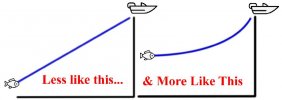Baxter
Well-Known Member
First to Admin: Wonder if there is a need for an "electronics help" type forum somewhere as well?
--------------
Next my question. Is there a formula for figuring out how far behind the boat your sonar reads? See image if I don't make sense
Using the depth, and perhaps knowing the angle from the Transducer I imagine a combination of Pythagorean Theorem and SohCahToa a person can do the math to figure it out, but the problem here I assume comes when a combination of boat speed and ping speed come into play, perhaps with other additional factors. I imagine the answer comes with more than just simple "triangle math".
I have searched to try and find a tool or calculator to help figure this out and have come up blank (so far). I hear some units display this figure, but as far as I know Lowrance does not (or at least I have not found where in the settings I can turn this on).
May be good to know considering I can easily figure out how far behind me my gear is and at what actual depth.
--------------
Next my question. Is there a formula for figuring out how far behind the boat your sonar reads? See image if I don't make sense
Using the depth, and perhaps knowing the angle from the Transducer I imagine a combination of Pythagorean Theorem and SohCahToa a person can do the math to figure it out, but the problem here I assume comes when a combination of boat speed and ping speed come into play, perhaps with other additional factors. I imagine the answer comes with more than just simple "triangle math".
I have searched to try and find a tool or calculator to help figure this out and have come up blank (so far). I hear some units display this figure, but as far as I know Lowrance does not (or at least I have not found where in the settings I can turn this on).
May be good to know considering I can easily figure out how far behind me my gear is and at what actual depth.



